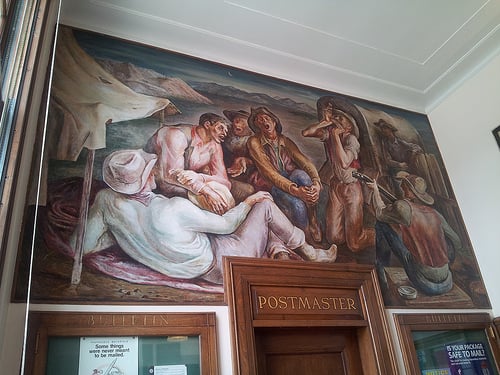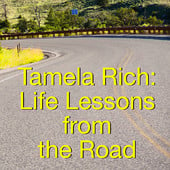 Mid-July, I stepped into the Greybull, Wyoming post office to ship home the miscellany I’d collected from the places I’d visited over the prior six weeks. The air conditioning, set at a refreshing, not freezing, temperature lulled me to pause and take in my surroundings. I should do that more often.
Mid-July, I stepped into the Greybull, Wyoming post office to ship home the miscellany I’d collected from the places I’d visited over the prior six weeks. The air conditioning, set at a refreshing, not freezing, temperature lulled me to pause and take in my surroundings. I should do that more often.
To my left, over the Postmaster’s door, was a mural that I somehow knew, even without the benefit of an art history degree, had been hand painted in my grandparents’ time. Chuck Wagon Serenade depicts a broad-shouldered cowboy lounging in the foreground, listening to three wranglers singing to the accompaniment of harmonica and guitar.
Public art in FDR’s New Deal
A quick internet search told me that this mural and many others throughout the country were commissioned as part of FDR’s New Deal. As Roosevelt’s relief administrator said in response to criticism for supporting the arts, “[artists] have got to eat just like other people.”
We might have lost a generation of works that resonate with the history of their day had the Roosevelt Administration not been so far-sighted.
A couple of things about this vignette might stick with you today. First, is the beauty that goes unnoticed when we hurry through our days. I think the Instagram craze has helped us slow down and notice the little things in our lives that are beautiful, especially the so-called ordinary things in life. Second, is the role of art in public life. The controversy over public art still rages, and I weigh in on that in my podcast if you’re interested in my take (just push the button at the top of this post and it will play for you). In short, I understand that art can be used for every purpose from the sublime to the profane and that some people are reluctant to spend public monies on it. But I’m glad we did then and still do.
Today, please gift yourself an extra five minutes to admire the beauty in everyday places: the fluted lamp post that holds the acorn-shaped globe; the brass handrail that reflects the afternoon sun; the wrought iron flourish over the entryway or the herringbone pattern of the brick walkway.
Then perhaps you might thank the thoughtful generation who left this visual legacy to you.
New to this series? Here’s the introduction.
 Subscribe to the podcast on iTunes here.
Subscribe to the podcast on iTunes here.